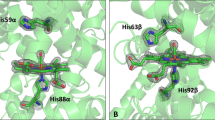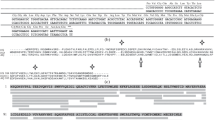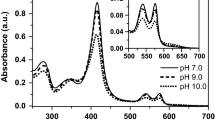Abstract
The amino acid sequence of βI-globin chain from Sindhi Krait (Bungarus sindanus sindanus) was determined to study the molecular evolution among snakes. The hemoglobin was isolated from the red blood cells and was analyzed by ion-exchange chromatography (IEX). The crude globin was subjected to reversed phased-high performance liquid chromatography (RP-HPLC) using C4 column. The N-terminal sequences of intact globin chains and tryptic peptides were determined by Edman degradation in a pulsed liquid gas phase sequencer using an online Phenylthiohydantoin analyzer. Sindhi Krait is expected to express three hemoglobin components that are composed of βII, βI, αD and αA-globin chains, as apparent by IEX, RP-HPLC and N-terminal sequence analyses. Sequence alignment and phylogenetic analyses of βI globin chain from Sindhi Krait showed closest relationship with βI globin chain from Rattlesnake, Water snake and Indigo snake. Interestingly, comparison of primary sequence of βI globin chain of Sindhi Krait with human β chain revealed 63 % similarity along with the retention of all heme contact points. Variations among the two sequences were prominent at αβ contact points and in regions directly not important for function.






Similar content being viewed by others
Abbreviations
- IEX:
-
Ion-exchange
- RP-HPLC:
-
Reversed phase-high performance liquid chromatography
- Bss:
-
B. s. sindanus/Bungarus sindanus sindanus
- TFA:
-
Trifluoroacetic acid
- TPCK:
-
Tosyl-phenylalanyl-chloromethyl-ketone
- PTH:
-
Phenylthiohydantoin
References
Schechter AN (2008) Hemoglobin research and the origins of molecular medicine. Blood 112:3927–3938
Marengo-Rowe AJ (2006) Structure-function relations of human hemoglobins. Baylor Univ Med Center Proc 19:239–245
Hardison RC (2012) Evolution of hemoglobin and its genes. Cold Spring Harb Perspect Med 2:a011627
Lukin JA, Ho C (2004) The structure-function relationship of hemoglobin in solution at atomic resolution. Chem Rev 104:1219–1230
Burmester T, Hankeln T (2014) Function and evolution of vertebrate globins. Acta Physiol 211:501–514
Storz JF, Opazo JC, Hoffmann FG (2013) Gene duplication, genome duplication, and the functional diversification of vertebrate globins. Mol Phylogenet Evol 66(2):469–478
Brittain T (2002) Molecular aspects of embryonic hemoglobin function. Mol Aspects Med 23:293–342
Pyron RA, Burbrink FT, Wiens JJ (2013) A phylogeny and revised classification of Squamata, including 4161 species of lizards and snakes. BMC Evol Biol 13:1–53
Wiens JJ, Hutter CR, Mulcahy DG, Noonan BP, Townsend TM, Sites JW, Reeder TW (2012) Resolving the phylogeny of lizards and snakes (Squamata) with extensive sampling of genes and species. Biol Lett 8(6):1043–1046
Sites JW, Reeder TW, Wiens JJ (2011) Phylogenetic insights on evolutionary novelties in lizards and snakes: sex, birth, bodies, niches, and venom. Annu Rev Ecol Evol Syst 42:227–244
Pough FH (1980) Blood oxygen transport and delivery in reptiles. Am Zool 20(1):173–185
Vidal N, Hedges SB (2009) The molecular evolutionary tree of lizards, snakes, and amphisbaenians. CR Biol 332:129–139
Bovo RP, Fuga A, Micheli-Campbell MA, Carvalho JE, Andrade DV (2015) Blood oxygen affinity increases during digestion in the South American Rattlesnake, Crotalus durissus terrificus. Comp Biochem Physiol A 186:75–82
Herman JK, Ingermann RL (1996) Effects of hypoxia and hyperoxia on oxygen-transfer properties of the blood of a viviparous snake. J Exp Biol 199:2061–2070
Amiel JJ, Chua B, Wassersug RJ, Jones DR (2011) Temperature-dependent regulation of blood distribution in snakes. J Exp Biol 214:1458–1462
Lombardi FR, Anazetti MC, Santos GC, Polizelli PP, Olivieri JR, Filguerira de Azevedo W, Bonilla-Rodriguez GO (2014) Oxygen binding properties and tetrameric stability of hemoglobins from the snakes Crotalus durissus terrificus and Liophis miliaris. In: Dunn BM (ed) Frontiers in protein and peptide sciences. Bentham, Beijing, pp 3–30
Gorr TA, Mable BK, Kleinschmidt T (1998) Phylogenetic analysis of reptilian hemoglobins: trees, rates, and divergences. J Mol Evol 47:471–485
Bonilla GO, Focesi A Jr, Bonaventura C, Bonaventura J, Cashon RE (1994) Functional properties of the hemoglobin from the South American snake Mastigodryas bifossatus. Comp Biochem Physiol A 109:1085–1095
Hoffmann FG, Storz JF, Gorr TA, Opazo JC (2010) Lineage-specific patterns of functional diversification in the α- and β-globin gene families of tetrapod vertebrates. Mol Biol Evol 27:1126–1138
Storz JF, Natarajan C, Moriyama H, Hoffmann FG, Wang T, Fago A, Malte H, Overgaard J, Weber RE (2015) Oxygenation properties and isoform diversity of snake hemoglobins. Am J Physiol Regul Integr Comp Physiol 309(9):1178–1191
Khan MS (2002) A guide to the snakes of Pakistan. Andreas S. Frankfurt am Main, Brahm
Riggs A (1981) Preparation of blood hemoglobins of vertebrates. Methods Enzymol 76:5–29
Rossi-Fanelli A, Antonini E (1958) Studies on the oxygen and carbon monoxide equilibria of human myoglobin. Arch Biochem Biophys 77:478–492
Hirs CHW, Stein WH, Moore S (1956) Peptides obtained by chymotryptic hydrolysis of performic acid oxidized ribonuclease. A partial structural formula for the oxidized protein. J Biol Chem 221:151–170
Hirs CHW (1967) Performic acid oxidation. Methods Enzymol 11:197–199
Felsenstein J (1989) PHYLIP—phylogeny inference package (Version 3.2). Cladistics 5:164–166
Hillis DM, Bull JJ (1993) An empirical test of bootstrapping as a method for assessing confidence in phylogenetic analysis. Syst Biol 42:182–192
Simpson RJ (2007) Performic acid oxidation of proteins. CSH Protoc. doi:10.1101/pdb.prot4698
Simpson RJ (2006) Fragmentation of protein using trypsin. CSH Protoc. doi:10.1101/pdb.prot4550
Storz JF, Hoffmann FG, Opazo JC, Sanger TJ, Moriyama H (2011) Developmental regulation of hemoglobin synthesis in the green anole lizard Anolis carolinensis. J Exp Biol 214:575–581
Naqvi S, Abbasi A, Zaidi ZH (1994) Primary structure of hemoglobin from cobra Naja naja naja. J Protein Chem 13:669–679
Eguchi Y, Eguchi T (2002) Amino acid sequence of the alpha and beta globin chains of the Hiroo sea snake (Laticauda laticaudata). J Protein Chem 21:215–221
Eguchi Y, Eguchi T (2003) Amino acid sequence of the alpha and beta globin chains of the Erabu sea snake (Laticaudia semifasciata). J Protein Chem 22:489–497
Stoeckeihuber M, Gorr T, Kleinschmidt T (2005) The primary structure of three hemoglobin chains from the Indigo snake (Drymarchon corais erebennus, Serpentes): first evidence for αD chains and two β chain types in snakes. Biol Chem 383:1907–1916
Islam A, Persson B, Zaidi ZH, Jörnvall H (1990) Sea snake (Microcephalophis gracilis) hemoglobin: primary structure and relationships to other forms. J Protein Chem 9:533–541
Acknowledgments
Humera Waheed gratefully acknowledges the support from Prof. Dr. Atta-ur-Rahman (FRS) and Prof. Dr. M. Iqbal Choudhary, Director, H.E.J. Research Institute of Chemistry, ICCBS, University of Karachi, Dean Ronald P. Jordon, Professor Dr. Zahir Shaikh, College of Pharmacy, University of Rhode Island and Dr. Zafar Zaidi Trust for travel grant. Part of this research work was completed at RI-INBRE Core Facility, University of Rhode Island, supported by NIGMS, NIH Grant # 8 P20 GM103430.
Author information
Authors and Affiliations
Corresponding author
Ethics declarations
Conflict of interest
The authors declare that they have no conflicts of interest with the contents of this article.
Rights and permissions
About this article
Cite this article
Waheed, H., Friedman, H., Moin, S.F. et al. The Primary Structure of βI-Chain of Hemoglobin from Snake Sindhi Krait (Bungarus sindanus sindanus). Protein J 35, 193–201 (2016). https://doi.org/10.1007/s10930-016-9661-2
Published:
Issue Date:
DOI: https://doi.org/10.1007/s10930-016-9661-2




